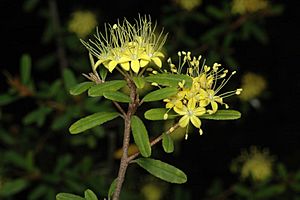Scaly phebalium facts for kids
Quick facts for kids Scaly phebalium |
|
|---|---|
 |
|
| Phebalium squamulosum subsp. squamulosum in the ANBG | |
| Scientific classification | |
| Genus: |
Phebalium
|
| Species: |
squamulosum
|
| Synonyms | |
|
|
The Phebalium squamulosum, also known as the scaly phebalium or forest phebalium, is a type of shrub or small tree. It is found only in eastern Australia, meaning it is endemic to that area. This plant has smooth branches that are covered with tiny, rust-coloured scales. Its leaves can be long and narrow, or shaped like an egg. The flowers are usually pale to bright yellow and grow in clusters called umbels. The back of the flowers also have rust-coloured or silvery scales.
Contents
What Does Scaly Phebalium Look Like?
The scaly phebalium is usually a shrub that grows up to 3 meters (about 10 feet) tall. Sometimes, it can even grow into a slender tree, reaching up to 7 meters (about 23 feet) high! Its young branches are smooth and covered with tiny, rust-coloured scales.
Leaves and Flowers
The leaves of the scaly phebalium can feel like paper or leather. They are usually long and narrow, or shaped like an egg, with the narrower end at the bottom. These leaves are between 7 and 70 millimeters (about 0.3 to 2.8 inches) long and 1.5 to 8 millimeters (about 0.06 to 0.3 inches) wide. They sit on a small stem called a petiole, which is about 0.5 to 4 millimeters long.
The top side of the leaves is mostly smooth. However, the underside is covered with shiny, silvery to rust-coloured scales and tiny star-shaped hairs.
The plant's flowers grow in clusters called umbels at the ends of the branches. Each cluster can have five to ten or more flowers. Each flower sits on a small stalk called a pedicel, which is about 3 to 8 millimeters long.
The base of the flower, called the calyx, is shaped like a half-sphere or a top. It is about 0.5 to 1.5 millimeters long and 1.2 to 2 millimeters wide. The inside of the calyx is smooth, but the outside is covered with scales.
The petals are the colourful parts of the flower. They are usually pale to bright yellow or cream-coloured and are shaped like an oval. They are about 2 to 4.5 millimeters long. The back of the petals also have silvery to rust-coloured scales. After the flower blooms, it produces a fruit called a follicle, which is about 3.5 millimeters long and stands upright.
How Scaly Phebalium Got Its Name
The scaly phebalium was first officially described in 1805 by a scientist named Étienne Pierre Ventenat. He wrote about it in his book Jardin de la Malmaison. This was the very first species in the Phebalium group to be described!
In 1970, another scientist named Paul Wilson identified ten different types, or subspecies, of Phebalium squamulosum. Eight of these subspecies are still recognized today by the Australian Plant Census. Some of these include:
- P. squamulosum subsp. alpinum
- P. squamulosum subsp. argenteum
- P. squamulosum subsp. coriaceum
- P. squamulosum subsp. gracile
- P. squamulosum subsp. lineare
- P. squamulosum subsp. ozothamnoides
- P. squamulosum subsp. parvifolium
- P. squamulosum subsp. squamulosum
Sometimes, it can be tricky to tell the different subspecies apart because they can have features that are a mix of different types.
Where Does Scaly Phebalium Grow?
The scaly phebalium is found in many places across eastern Australia. It mainly grows in areas with heath (a type of shrubland) and forests that have sandstone soil. You can find it in northern and south-eastern Queensland, eastern New South Wales, and eastern Victoria.
Using Scaly Phebalium in Gardens
People often grow Phebalium squamulosum in their gardens because it has beautiful flowers. It's a great ornamental shrub! This plant can handle cold weather and light frost. It grows best in a spot where the soil drains well and it gets some shade. It also likes its roots to stay cool and a bit moist.
Image gallery
-
P. squamulosum, Ku-ring-gai Chase National Park, 19 August 2017
-
P. squamulosum buds, Ku-ring-gai Chase National Park, 24 July 2011
-
P. squamulosum subsp. gracile, in the ANBG
-
P. squamulosum subsp. lineare, in the ANBG
See also
 In Spanish: Phebalium squamulosum para niños
In Spanish: Phebalium squamulosum para niños






